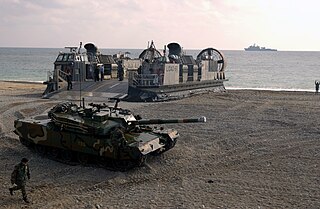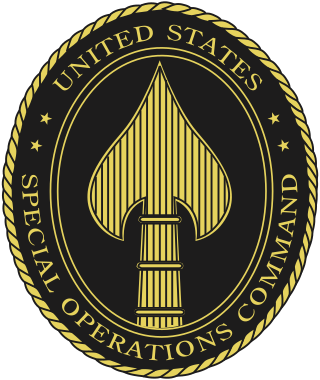
The Fifth Fleet is a numbered fleet of the United States Navy. Its area of responsibility encompasses approximately 2.5 million square miles, and includes the Persian Gulf, Red Sea, Arabian Sea, and parts of the Indian Ocean. It shares a commander and headquarters with U.S. Naval Forces Central Command (NAVCENT) in Bahrain. Fifth Fleet/NAVCENT is a component command of, and reports to, U.S. Central Command (CENTCOM).

The USS Mitscher (DDG-57) is an Arleigh Burke class in service with the United States Navy. It was constructed by Ingalls Shipbuilding, in Pascagoula, Mississippi on an order in December 1988. Laid down in 1992 it was formally commissioned on 10 December 1994.

A military exercise, training exercise, maneuver (manoeuvre), or war game is the employment of military resources in training for military operations. Military exercises are conducted to explore the effects of warfare or test tactics and strategies without actual combat. They also ensure the combat readiness of garrisoned or deployable forces prior to deployment from a home base.

The United States Joint Forces Command (USJFCOM) was a Unified Combatant Command of the United States Department of Defense. USJFCOM was a functional command that provided specific services to the military. The last commander was Army Gen. Ray Odierno and the Command Senior Enlisted was Marine Sergeant Major Bryan B. Battaglia. As directed by the President to identify opportunities to cut costs and rebalance priorities, Defense Secretary Robert Gates recommended that USJFCOM be disestablished and its essential functions reassigned to other unified combatant commands. Formal disestablishment occurred on 4 August 2011.

Exercise Red Flag is a two-week advanced aerial combat training exercise held several times a year by the United States Air Force. It aims to offer realistic air-combat training for military pilots and other flight crew members from the United States and allied countries.

Paul K. Van Riper is a retired United States Marine lieutenant general. Van Riper was a combat veteran—twice receiving the Silver Star Medal for his heroic actions during the Vietnam War. At the time of his retirement, Van Riper was serving as the Commanding General, 2nd Marine Division and Marine Corps Combat Development Command, Quantico, Virginia. Since his retirement, Van Riper has served on several advisory boards and panels. He is currently the Chairman of the Board of Directors for the Marine Corps Heritage Foundation.

A man-to-man wargame is a wargame in which units generally represent single individuals or weapons systems, and are rated not only on weaponry but may also be rated on such facets as morale, perception, skill-at-arms, etc. The game is designed so that a knowledge of military tactics, especially at the small unit or squad level, will facilitate successful gameplay. Man-to-man wargames offer an extreme challenge to the designer, as fewer variables or characteristics inherent in the units being simulated are directly quantifiable. Modern commercial board wargaming stayed away from man-to-man subjects for many years, though once the initial attempts were made to address the subject, it has evolved into a popular topic among wargamers.
The Fleet Problems are a series of naval exercises of the United States Navy conducted in the interwar period, and later resurrected by Pacific Fleet around 2014.

Command and control is a "set of organizational and technical attributes and processes ... [that] employs human, physical, and information resources to solve problems and accomplish missions" to achieve the goals of an organization or enterprise, according to a 2015 definition by military scientists Marius Vassiliou, David S. Alberts, and Jonathan R. Agre. The term often refers to a military system.

Military simulations, also known informally as war games, are simulations in which theories of warfare can be tested and refined without the need for actual hostilities. Military simulations are seen as a useful way to develop tactical, strategical and doctrinal solutions, but critics argue that the conclusions drawn from such models are inherently flawed, due to the approximate nature of the models used. Many professional analysts object to the term wargames as this is generally taken to be referring to the civilian hobby, thus the preference for the term simulation.
Purdue University's Synthetic Environment for Analysis and Simulations, or SEAS, is currently being used by Homeland Security and the US Defense Department to simulate crises on the US mainland. SEAS "enables researchers and organizations to try out their models or techniques in a publicly known, realistically detailed environment." It "is now capable of running real-time simulations for up to 62 nations, including Iraq, Afghanistan, and China. The simulations gobble up breaking news, census data, economic indicators, and climactic events in the real world, along with proprietary information such as military intelligence. [...] The Iraq and Afghanistan computer models are the most highly developed and complex of the 62 available to JFCOM-J9. Each has about five million individual nodes representing things such as hospitals, mosques, pipelines, and people."
Intelligence dissemination management is a maxim of intelligence arguing that intelligence agencies advise policymakers instead of shaping policy. Due to the necessity of quick decision-making in periods of crisis, intelligence analysts may suggest possible actions, including a prediction of the consequences of each decision. Intelligence consumers and providers still struggle with the balance of what drives information flow. Dissemination is the part of the intelligence cycle that delivers products to consumers, and intelligence dissemination management refers to the process that encompasses organizing the dissemination of the finished intelligence.

Foal Eagle is a combined field training exercise (FTX) conducted annually by the Republic of Korea Armed Forces and the United States Armed Forces under the auspices of the Combined Forces Command. It is one of the largest military exercises conducted annually in the world. Foal Eagle has been a source of friction with the government of Democratic People's Republic of Korea (DPRK) and domestic ROK critics.

The Joint Enabling Capabilities Command (JECC) is a subordinate command of United States Transportation Command, headquartered at Naval Station Norfolk, Virginia. It was previously part of United States Joint Forces Command. It developed from the Standing Joint Force Headquarters concept trialed during Exercise Millennium Challenge 2002.
Bold Alligator is a multinational littoral warfare exercise hosted by the United States. It has been held annually since 2011. In 2012, it involved 14,000 marines, sailors, airmen and soldiers, encompassing more than 25 ships and involving eleven countries, with Canada, Mexico, UK, France, Netherlands, Spain, Italy, New Zealand, Australia, and other allied nations participating at sea, on land, and in the air, at Camp Lejeune, North Carolina and in Virginia.
The Joint Theater Level Simulation (JTLS) is used to simulate joint, combined, and coalition civil-military operations at the operational level. Used for civil/military simulations and humanitarian assistance/disaster relief (HA/DR) scenarios, JTLS is an interactive, computer-assisted simulation that models multi-sided air, ground, and naval resources with logistical Special Operation Forces (SOF) and intelligence support. The primary purpose of JTLS is to create a realistic environment in which agency staff can operate as they would within a real-world or operational situation. A training audience conducts a scenario or event to practice their ability to coordinate various staff functions.
The Sigma I-64 war game, one of the Sigma war games, was played from 6 to 9 April 1964. Its purpose was to test scenarios of escalation of warfare in Vietnam. After rigorous research into information needed to form a scenario, a simulation took place, with knowledgeable officials playing out the roles of actual government decision makers. Participants were drawn from the State Department, Department of Defense, the Central Intelligence Agency, and the Joint Chiefs of Staff. In Sigma I-64, the scenarios to be examined were the burgeoning Viet Cong insurgency in Vietnam, and the possible use of U.S. air power against it.
Military exercises are conducted by the Pakistan Armed Forces to increase combat readiness, and to identify problems in logistics, training, and current military doctrine. They also test the ability of units to work together. Lastly, they act as a visible expression of military might, which acts as a deterrent to potential enemy action. An important component of each exercise is the after-action assessment. Since 1989 the four branches services have increasingly begun coordinated exercises.

The United States Special Operations Command is the unified combatant command charged with overseeing the various special operations component commands of the Army, Marine Corps, Navy, and Air Force of the United States Armed Forces. The command is part of the Department of Defense and is the only unified combatant command created by an Act of Congress. USSOCOM is headquartered at MacDill Air Force Base in Tampa, Florida.

A wargame, generally, is a type of strategy game which realistically simulates warfare. A professional wargame, specifically, is a wargame that is used by military organizations to train officers in tactical and strategic decision-making, to test new tactics and strategies, or to predict trends in future conflicts. This is in contrast to recreational wargames, which are designed for fun and competition.













